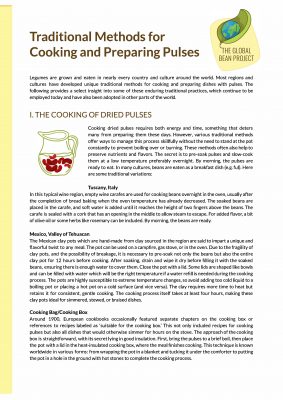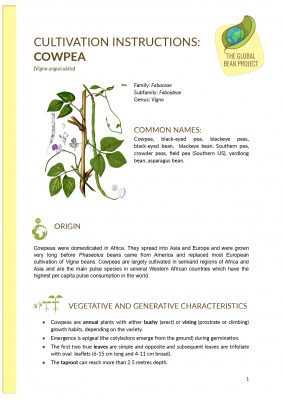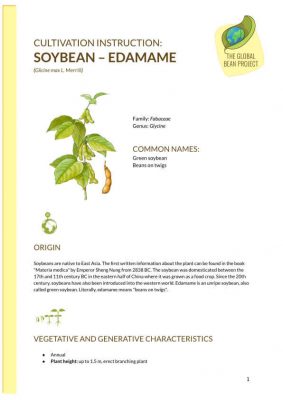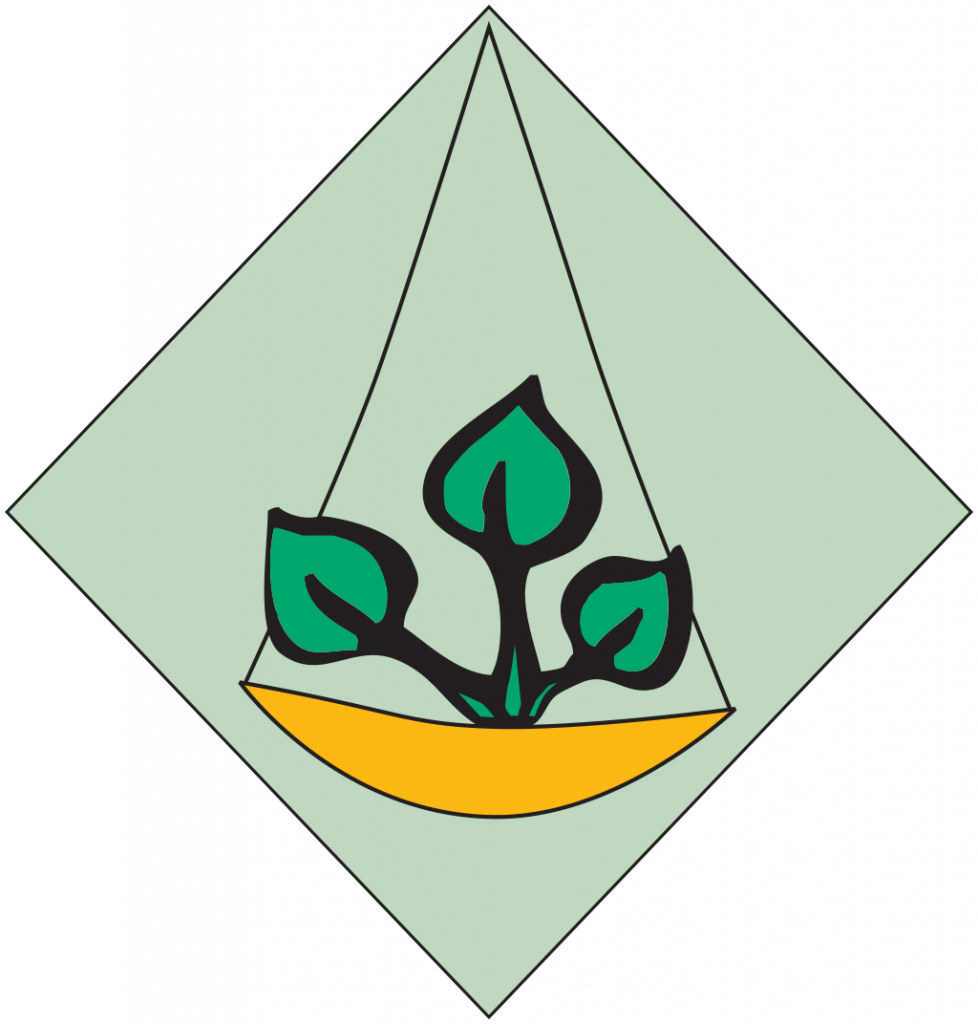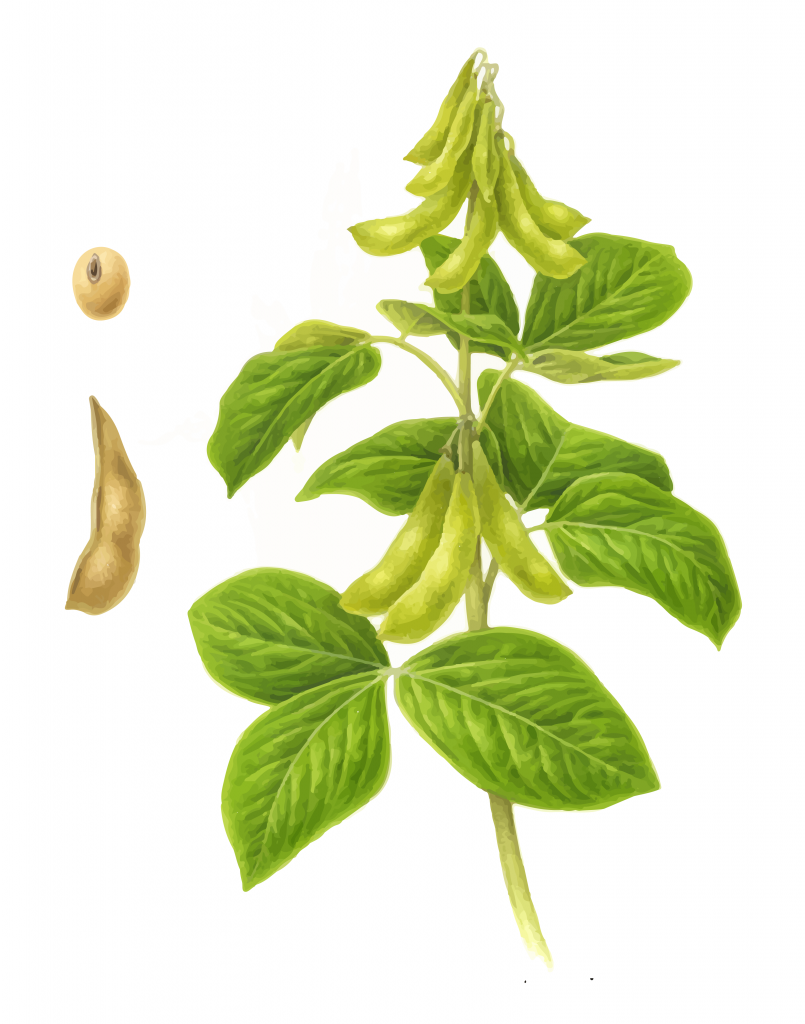
(Glicine max L. Merrill)
Family: Fabaceae
Genus: Glycine
Common names:
Green soybean
Beans on twigs

ORIGIN
Soybeans are native to East Asia. The first written information about the plant can be found in the book “Materia medica” by Emperor Sheng Nung from 2838 BC. The soybean was domesticated between the 17th and 11th century BC in the eastern half of China where it was grown as a food crop. Since the 20th century, soybeans have also been introduced into the western world. Edamame is an unripe soybean, also called green soybean. Literally, edamame means “beans on twigs”.
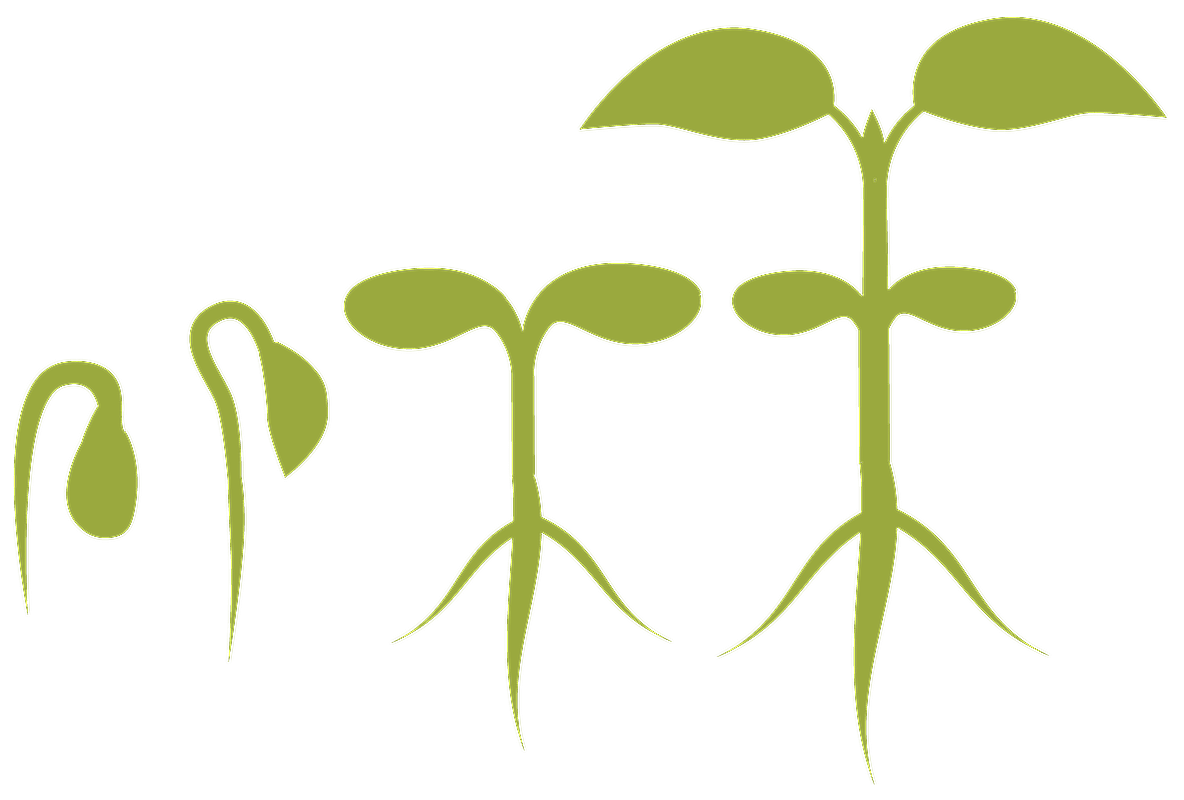
VEGETATIVE AND GENERATIVE CHARACTERISTICS
- Annual
- Plant height: up to 1.5 m, erect branching plant
- Maturity: Ranked in maturity groups of 000 – 10. The optimal maturity groups for cultivation in Europe are 000 – 5 with a vegetation period from 90 to 120 days.
- Varieties: differing by seed and pod colour, ranging from light-coloured beans and bright green pods to dark-seeded soybeans with grey or light brown hairs on the pods.
- Pods: One pod containing usually 2 – 3 beans.
- Stem: erect, covered with a thick grey or brown down of small hairs.
- Flower: Self-fertilising, very small, maximum size of 6 mm. The flower’s colour is white, sometimes with a shade of purple.

SOIL AND CLIMATE
- Short-day plant, sensitive to photoperiod that limits its geographical area of cultivation. Depending on the maturity group, it is possible to grow soybean from 38° N to 50° N latitude in Europe.
- Prefers a warm growing season, plentiful water and sunlight, due to its origin.
- Optimal temperature for growing is 20 – 25 °C, but at the same time resistant to short-termperiods of low temperatures and late short-term frosts.
- Can be cultivated in most types of soil, but thrives best in warm, fertile, well-drained, loamy soil with a pH of 6.5. Shallow soils, poor structures and extremely acidic soils should be avoided.

CULTIVATION PRACTICES
- Very suitable for growing as a vegetable in gardens, as it can give a satisfactory yield on a small area while reducing usage of nitrogen fertiliser.
- Sowing conditions: Very susceptible in the emergence stage. Pre-sowing soil preparation is very important to form a smooth, level seed bed, providing good seed-to-soil contact and uniform emergence and growth. Environmental conditions play a large role in affecting seedling emergence. Heavy rainfall immediately after planting can cause compaction and crusting on some soil types, making emergence difficult.
- Inoculation: High nitrogen supply is needed, due to the high protein content of the plant. Inoculation of soybean seeds with nitrogen-fixing bacteria (Bradyrhizobium japonicum) is low-cost and represents an environmentally friendly source of nitrogen. Usually if you buy seeds, the inoculant is free of charge. Inoculant contains live strains of Rhizobium bacteria and care should be taken during seed inoculation: do it gently, just before sowing (on the same day), in the shade. At the farm or gardening level this can be done using a cement mixer (for large quantities) or by using big-bags and gently mixing inoculant and seeds.
- Importance of sowing date: Soybean seeds are sensitive to cold soil, where the emergence can lenghten to 25 days. Sowing of soybean should start when the soil temperature at a depth of 4 – 8 cm reaches 10 – 12 °C and in such conditions the emergence begins after 5-6 days. The varieties which require a longer growing season are sown first. Maturity is the most important criterion in selecting a variety. If a variety is too early or too late at a location, it will be limited in potential performance. The optimum sowing depth is 4 – 5 cm.
- Row spacing: Since soybean has great branching potential, plant density should be low. The most common mistake in practice is to sow soybean a little too dense, especially if the expected germination rate of seeds is low, which sometimes results in very dense canopies, negatively affecting branching, increasing lodging and reducing yield. The recommended row spacing is 50 cm. Within-row spacing depends on maturity groups and row width and usually is ranged from 2 to 4 cm.
- Weed control: The first five weeks after soybean emergence are most critical for weed control in order to avoid yield reductions. Seedbed preparation to kill early-emerging weeds is the first step. Weed control operations can include a rotary hoe, harrow or tine weeder. Rotary hoeing or harrowing and the first row cultivation are the most important operations to reduce losses to weeds. In good conditions, the quick canopy closure occurs and the weeds soon lose the race.

PESTS AND DISEASES
- If harvested while it is still green, it is possible to avoid many diseases that occur in the later period of soybean vegetation. Disease management includes: use of tolerant or resistant varieties, crop rotation with non-susceptible crops such as maize or wheat (reduces the presence of soybean-specific organisms in the soil), good tillage practice and the possible use of fungicides.
- White mold (Sclerotinia sclerotiorum): pathogenic fungus with a wide host range including soybean, occurs in continuous cool temperatures and saturated soils. The fungus invades the plant stems and colonises the vascular tissue of the plants. Initial symptoms are grey to white lesions at the nodes which rapidly progress above and below the nodes, sometimes girdling the stem. White, fluffy mold soon covers the infected area, especially during periods of high relative humidity.
- Powdery mildew (Microsphaera diffusa): occurs late in the season during periods of cool, cloudy weather. Infected leaves have white to light grey, powdery patches, which may enlarge and cover the surfaces of many leaves throughout a plant.
- Phytophthora root and stem rot (Phytophthora sojae): infects plants early in the season after wet weather, usually in clay and compacted soils. Seedlings can be attacked and killed in the ground or soon after emergence. Plants may die throughout the season. On infected plants, brown lesions form on the roots, the roots rot and degrade, and a dark chocolate-brown discoloration of the stem often extends from below the soil line upward into lower parts of the plant.
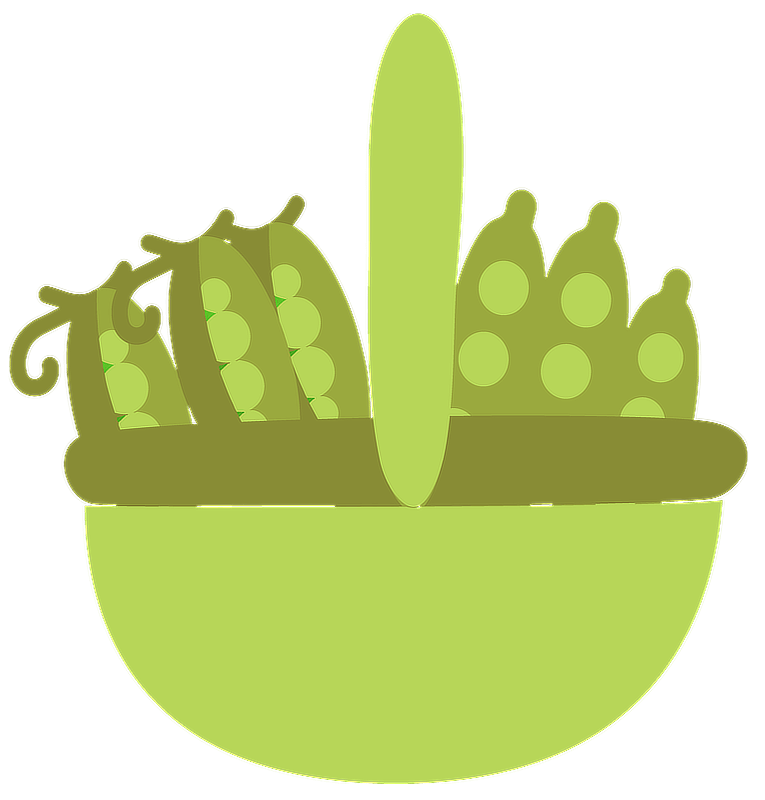
HARVEST AND USE
- A very critical aspect for producing quality edamame is harvesting when the pods are at least 85% filled but before they start to turn from a bright green to a yellowed colour.
- Tip: For the best taste, harvest the pods in the evening.
- Storage: Fresh edamame should be refrigerated and used within two days. Frozen edamame canbe stored in the freezer for several months.
- Usage: Edamame is very easy to prepare as a snack or in vegetable meals and soups, and thetaste is amazing. The two most important components of flavour are sweet and savoury. In Japan and other Asian countries, it is very popular to eat cold salted edamame with beer. The pods are slightly boiled in salted water and the seeds are then directly squeezed from the pods into the mouth.

FURTHER INFORMATION
Edamame contains numerous healthy components such as isoflavones, soy proteins, saponins and fibres, calcium, as well as significant quantities of vitamins (A, B and C). The soy protein has a high biological value and contains all the essential amino acids. Studies have shown that edamame is rich in sterols – substances that strengthen the immune system, protect against cancer as well as heart disease. Due to high content of isoflavones the populations, which regularly consume soyfoods, have lower incidences of developing hormone-dependent cancers.
TIMELINE
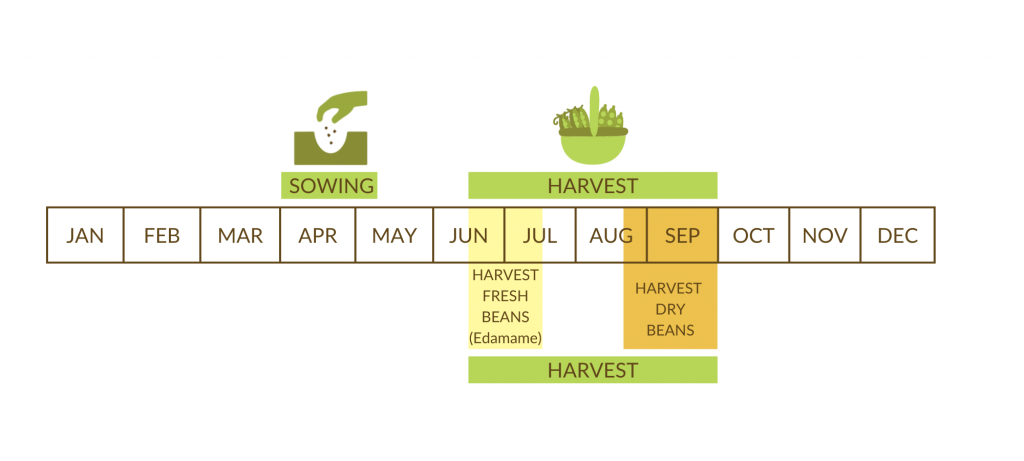
Recipes
Find recipes with soybeans on our recipe page!
Youtube ShowGardens videos
The Global Bean Show Garden videos present the cultivation and uses of legumes in gardens and fields. Each “Show gardener” sends us a series of videos showing one or more legume species throughout their growing season. Some of our videos give an overview of specific aspects of legume cultivation. Discover here the videos about soybean!



